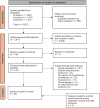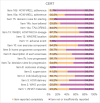Evaluation and Synthesis of Physiotherapy Protocols for Femoroacetabular Impingement Syndrome (FAIS): A Scoping Review
- PMID: 40574967
- PMCID: PMC12199656
- DOI: 10.33393/aop.2025.3381
Evaluation and Synthesis of Physiotherapy Protocols for Femoroacetabular Impingement Syndrome (FAIS): A Scoping Review
Abstract
Introduction: The physiotherapeutic treatment of femoroacetabular impingement syndrome (FAIS) is a topic of growing interest in the literature. The aim of this study is to present all of the treatment modalities used in scientific research in order to analyze the extent to which the protocols are explicit.
Method: This is a scoping review. The literature search was performed using the Cochrane, Embase and PubMed databases. The data was collected in various tables and the protocols were assessed using the Template for Intervention Description and Replication (TIDieR) and the Consensus on Exercise Reporting Template (CERT) tools.
Results: Twenty-four studies were selected and 30 protocols were analyzed. The most frequently reported treatment modalities were strengthening (n = 25), manual therapy (n = 22) and stretching (n = 21). The average total score was 47% for studies evaluated by the TIDieR checklist and 40% for studies evaluated by the CERT checklist.
Discussion: The treatment modalities identified are similar to those used for other musculoskeletal conditions. Specific treatments were found and were generally consistent with the clinical characteristics of FAIS. The lack of precision in the reporting of interventions compromises their clinical use. The same lack of detail is noted for other physiotherapeutic interventions in the musculoskeletal field.
Conclusion: Numerous treatment methods are presented in the literature. However, the protocols lack in explicitness and the use of the TIDieR and CERT evaluation grids is not widespread.
Keywords: CERT; Exercises; Femoroacetabular Impingement; Intervention Protocol; Physical Therapy; TIDieR.
© 2025 The Authors.
Conflict of interest statement
Conflict of interest: The authors declare no conflict of interest.
Figures








Similar articles
-
The educational effects of portfolios on undergraduate student learning: a Best Evidence Medical Education (BEME) systematic review. BEME Guide No. 11.Med Teach. 2009 Apr;31(4):282-98. doi: 10.1080/01421590902889897. Med Teach. 2009. PMID: 19404891
-
Home treatment for mental health problems: a systematic review.Health Technol Assess. 2001;5(15):1-139. doi: 10.3310/hta5150. Health Technol Assess. 2001. PMID: 11532236
-
Cost-effectiveness of using prognostic information to select women with breast cancer for adjuvant systemic therapy.Health Technol Assess. 2006 Sep;10(34):iii-iv, ix-xi, 1-204. doi: 10.3310/hta10340. Health Technol Assess. 2006. PMID: 16959170
-
Physical activity and exercise for chronic pain in adults: an overview of Cochrane Reviews.Cochrane Database Syst Rev. 2017 Apr 24;4(4):CD011279. doi: 10.1002/14651858.CD011279.pub3. Cochrane Database Syst Rev. 2017. PMID: 28436583 Free PMC article.
-
Physical activity and exercise for chronic pain in adults: an overview of Cochrane Reviews.Cochrane Database Syst Rev. 2017 Jan 14;1(1):CD011279. doi: 10.1002/14651858.CD011279.pub2. Cochrane Database Syst Rev. 2017. Update in: Cochrane Database Syst Rev. 2017 Apr 24;4:CD011279. doi: 10.1002/14651858.CD011279.pub3. PMID: 28087891 Free PMC article. Updated.
References
-
- Charles T, Bloemers N, Deneubourg M, Schuind F, Jayankura M. Femoro-acetabular conflict : A cause of osteoarthritis of the young subject. Rev Med Brux. 2019;40(4):318–323.
-
- Peters MD, Godfrey CM, Mclnerney P, Munn Z, Tricco AC, Khalil H. Scoping reviews (2020 version). In: JBI Manual for Evidence Synthesis. JBI; 2020 doi: 10.46658/JBIMES-20-12. chap 11, - DOI
Publication types
LinkOut - more resources
Full Text Sources

